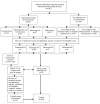Understanding adenomyosis: a case control study
- PMID: 19643403
- PMCID: PMC3150965
- DOI: 10.1016/j.fertnstert.2009.06.049
Understanding adenomyosis: a case control study
Abstract
Objective: To elucidate the clinical profile of adenomyosis by comparison with uterine leiomyomas.
Design: Retrospective case-control study.
Setting: Academic medical center.
Patient(s): The study comprised 76 women undergoing hysterectomy with adenomyosis and 152 women with uterine leiomyomas but no adenomyosis.
Intervention(s): Retrospective medical record review of hospital and ambulatory records.
Main outcome measure(s): Comparison of women undergoing hysterectomy with a sole pathologic finding of adenomyosis and women with leiomyomas alone.
Result(s): Adenomyosis was independently associated with younger age (41.1 years vs. 44.3 years), history of depression (57.1% vs. 24.7%), dysmenorrhea (65.7% vs. 42.3%), and pelvic pain (52.9% vs. 21.1%) in a multivariable unconditional logistic regression analysis compared with women with leiomyomas, where women from both groups had gynecologic symptoms. Furthermore, in a second multivariate model where all subjects had uteri weighing>150 g, women with adenomyosis were more likely to have a history of depression (52.6% vs. 22.2%) and endometriosis (26.3% vs. 2.8%) compared with women with leiomyomas.
Conclusion(s): Women undergoing hysterectomy with a histologic diagnosis of adenomyosis have a distinct symptomatology and medical history compared with women with leiomyomas. Better understanding of this disease is required to improve diagnosis and management.
Copyright (c) 2010. Published by Elsevier Inc.
Figures
Similar articles
-
Characteristics indicating adenomyosis coexisting with leiomyomas: a case-control study.Hum Reprod. 2010 May;25(5):1177-82. doi: 10.1093/humrep/deq034. Epub 2010 Feb 22. Hum Reprod. 2010. PMID: 20176591 Free PMC article.
-
Clinical characteristics indicating adenomyosis at the time of hysterectomy: a retrospective study in 291 patients.Arch Gynecol Obstet. 2012 Jun;285(6):1571-6. doi: 10.1007/s00404-011-2180-7. Epub 2011 Dec 23. Arch Gynecol Obstet. 2012. PMID: 22193824
-
Clinical characteristics indicating adenomyosis coexisting with leiomyomas: a retrospective, questionnaire-based study.Fertil Steril. 2014 Jan;101(1):237-241.e1. doi: 10.1016/j.fertnstert.2013.09.038. Epub 2013 Nov 1. Fertil Steril. 2014. PMID: 24188881
-
Benign myometrial conditions: leiomyomas and adenomyosis.Top Magn Reson Imaging. 2003 Aug;14(4):281-304. doi: 10.1097/00002142-200308000-00003. Top Magn Reson Imaging. 2003. PMID: 14578775 Review.
-
Diagnosing adenomyosis: an integrated clinical and imaging approach.Hum Reprod Update. 2020 Apr 15;26(3):392-411. doi: 10.1093/humupd/dmz049. Hum Reprod Update. 2020. PMID: 32097456 Review.
Cited by
-
The Role of Platelets in the Pathogenesis and Pathophysiology of Adenomyosis.J Clin Med. 2023 Jan 20;12(3):842. doi: 10.3390/jcm12030842. J Clin Med. 2023. PMID: 36769489 Free PMC article. Review.
-
Unveiling the Pathogenesis of Adenomyosis through Animal Models.J Clin Med. 2022 Mar 21;11(6):1744. doi: 10.3390/jcm11061744. J Clin Med. 2022. PMID: 35330066 Free PMC article. Review.
-
An Appraisal of the Tissue Injury and Repair (TIAR) Theory on the Pathogenesis of Endometriosis and Adenomyosis.Biomolecules. 2023 Jun 11;13(6):975. doi: 10.3390/biom13060975. Biomolecules. 2023. PMID: 37371555 Free PMC article. Review.
-
Epidemiology of Adenomyosis.Semin Reprod Med. 2020 May;38(2-03):89-107. doi: 10.1055/s-0040-1718920. Epub 2020 Oct 26. Semin Reprod Med. 2020. PMID: 33105509 Free PMC article. Review.
-
Characteristics indicating adenomyosis coexisting with leiomyomas: a case-control study.Hum Reprod. 2010 May;25(5):1177-82. doi: 10.1093/humrep/deq034. Epub 2010 Feb 22. Hum Reprod. 2010. PMID: 20176591 Free PMC article.
References
-
- Azziz R. Adenomyosis: current perspectives. Obstet Gynecol Clin North Am. 1989;16:221–35. - PubMed
-
- Walker CL, Stewart EA. Uterine fibroids: the elephant in the room. Science. 2005;308:1589–92. - PubMed
-
- Gordts S, Brosens JJ, Fusi L, Benagiano G, Brosens I. Uterine adenomyosis: a need for uniform terminology and consensus classification. Reprod Biomed Online. 2008;17:244–8. - PubMed
-
- Stewart EA. Uterine fibroids. Lancet. 2001;357:293–8. - PubMed
MeSH terms
Grants and funding
LinkOut - more resources
Full Text Sources
Medical


